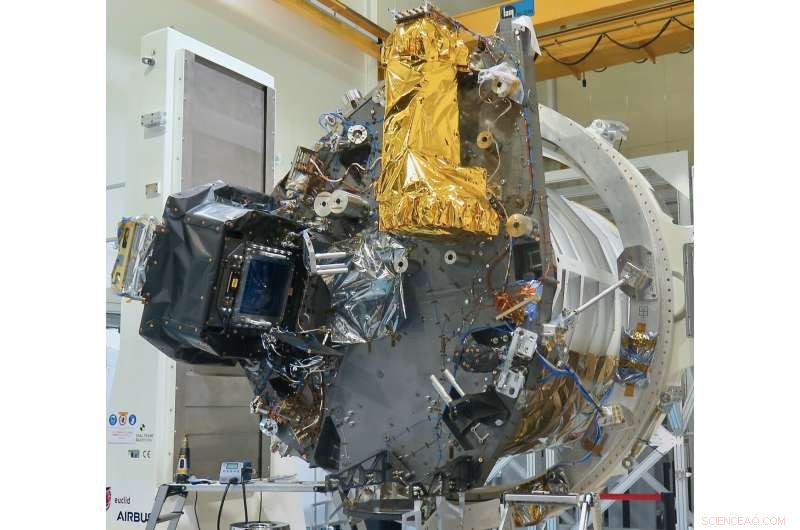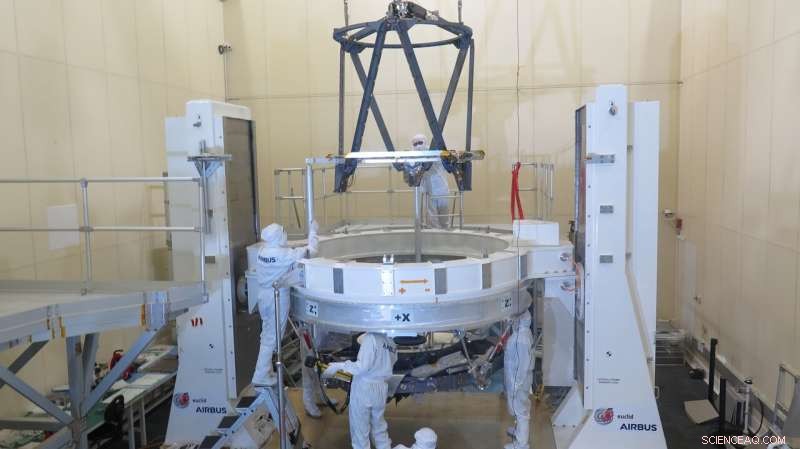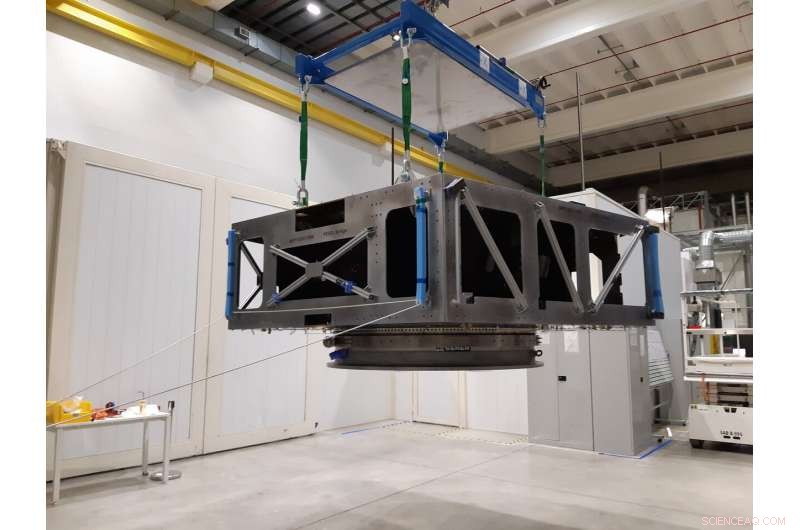
Gli strumenti VIS e NISP sul modulo payload di Euclid. Credito:Airbus
La missione Euclid dell'ESA ha raggiunto un'altra pietra miliare nel suo viaggio verso il lancio. I suoi due strumenti sono ora costruiti e completamente testati. Questi sono stati consegnati all'Airbus Defence and Space di Tolosa, Francia, dove ora vengono integrati con il telescopio per formare il modulo di carico utile della missione.
Euclid è costituito da un telescopio a specchio di 1,2 metri progettato per funzionare a lunghezze d'onda sia visibili che vicine all'infrarosso, quest'ultima appena più lunga della luce rossa che gli umani possono vedere. Il telescopio raccoglierà la luce da oggetti cosmici distanti e la alimenterà in due strumenti.
Lo strumento Visibile (VIS) e il Near Infrared Spectrometer and Photometer (NISP) funzioneranno in parallelo, registrare dati simultaneamente da qualsiasi parte del cielo verso cui è puntato il telescopio.
La missione di Euclide è misurare le forme di più di un miliardo di galassie, e gli accurati spostamenti verso il rosso di decine di milioni di galassie in più di un terzo del cielo. Il redshift è un effetto causato dall'espansione dell'Universo. Allunga la lunghezza d'onda della luce emessa da galassie lontane; più lontana è la galassia, quanto più estremo è il suo redshift. Le galassie nell'indagine di Euclide copriranno 10 miliardi di anni di storia cosmica, e consentire agli scienziati di indagare sulla misteriosa materia oscura e sull'energia oscura che si pensa dominino l'Universo.
Lo strumento VIS gestirà la misurazione precisa delle forme delle galassie prendendo le migliori immagini di galassie lontane possibili. Per fare questo, lo strumento utilizza un mosaico di 36 CCD, ognuno dei quali contiene 4000 pixel per 4000 pixel. Questo dà al rilevatore un totale di circa 600 megapixel.
"Il design, sviluppo, produzione, il test e la calibrazione dello strumento VIS nell'arco di una dozzina di anni secondo una specifica rigorosa è stata una sfida, "dice Mark Cropper, Capo dello strumento VIS e professore presso l'UCL Mullard Space Science Laboratory, UK.
"Siamo immensamente orgogliosi di ciò che il team VIS ha raggiunto per portare questo progetto al suo culmine. Che la performance finale superi le nostre aspettative è un tributo alla loro esperienza, dedizione e professionalità».
Non solo il numero di pixel è impressionante, lo strumento fornirà anche la migliore sensibilità in condizioni di scarsa illuminazione su un'ampia gamma di lunghezze d'onda con lunghi tempi di integrazione.
"Questi sono CCD molto speciali, sono stati sviluppati appositamente per Euclid nel corso di molti anni, "dice Alex Short, Ingegnere del carico utile VIS dell'ESA.
L'altro strumento, NISP, è dedicato a effettuare misurazioni spettroscopiche di galassie, che comporta la suddivisione della loro luce in singole lunghezze d'onda. Ciò consente di dedurre i redshift. Questa proprietà consente ai cosmologi di stimare la distanza dalla galassia in questione, e consentirà di trasformare i dati di Euclide nel più grande, la più accurata indagine 3D dell'Universo mai condotta.
"Il team internazionale NISP e le industrie di supporto hanno svolto un lavoro incredibile per progettare, sviluppare e testare questo strumento impegnativo, "dice Thierry Maciaszek, Responsabile del progetto dello strumento NISP, dal CNES e dal Laboratoire d'Astrophysique de Marseille, Francia.
"Questo è, però, non è la fine della storia per noi poiché molte attività importanti devono essere completate con NISP a livello satellitare. Stiamo aspettando con impazienza la prima luce in volo che dimostri le eccellenti prestazioni globali".
Il rivelatore NISP presenterà il più grande campo visivo mai volato nello spazio per uno strumento a infrarossi.
"La qualità dell'ottica è semplicemente incredibile, "dice Tobias Boenke, Mission System &NISP Instrument Engineer presso l'ESA.
Un fattore chiave per ottenere l'eccezionale precisione ottica di Euclid è stata la decisione presa all'inizio della storia del progetto di costruire l'intero modulo di carico utile in carburo di silicio. L'uso di questo materiale all'ESA è stato pionieristico nella produzione del telescopio per la missione spaziale Herschel. Nella missione Gaia dell'ESA, la struttura di supporto per i sottosistemi del veicolo spaziale è stata montata su un telaio in carburo di silicio. Su Euclide, il materiale è stato utilizzato sia per gli strumenti che per il telescopio.
Mentre il metallo si espande e si contrae al variare della sua temperatura, thus degrading an optical system's ability to focus light, silicon carbide is extremely stable to such variations in temperature. But using the compound brings its own challenges. Silicon carbide is a ceramic and so much more brittle than metal.

The supporting structure of the telescope’s secondary mirror for ESA’s Euclid spacecraft being brought together for final integration and optical alignment at Airbus in Toulouse, Francia. Credito:Airbus
"It was a big challenge to be able to manufacture the instruments from this material and make sure they can remain undamaged during the launch, " adds Tobias.
Like VIS, NISP also uses specially designed state-of-the-art detectors to record the faint light coming from distant stars and galaxies. Unlike VIS, NISP can also operate in spectrographic mode. The detectors, which are operated at –180°C to provide ultra-low noise and high sensitivity, register these 'spectra' and convert them into tiny electronic signals. These signals can then be amplified and accurately measured to provide the photometric and spectroscopic redshifts.
The instruments will receive light from Euclid's telescope, which has already been assembled at Airbus, Toulouse. Like the instruments, it too is made from silicon carbide and is a state-of-the art construction in all senses.
"We are pushing all the manufacturing levels to the limit, " says Luis Miguel Gaspar Venancio, ESA's Mission Performance &Optical Systems Engineer.
A special component behind the telescope, called the dichroic, separates the collected light and diverts the visible wavelengths to VIS and the infrared wavelengths to NISP.
When the information from VIS and NISP is combined, scientists will be able to deduce the way that the Universe's large-scale distribution of galactic structures has built up throughout cosmic history. This will help them determine the speed at which such structures grow, providing strong constraints on the nature and amount of dark matter and dark energy in the Universe.
The instruments were prepared for delivery to Airbus just before the COVID-19 pandemic imposed restrictions and lockdowns in many ESA member states. Fortunatamente, VIS was already at Airbus, and NISP had to wait for a few weeks for shipment from Marseille to Toulouse, but was not on the critical path.
"I am extremely grateful to all project parties:institutes, industry and colleagues at ESA for their dedication and commitment during these difficult times, " says Giuseppe Racca, ESA's Euclid project manager.

The flight model of ESA’s Euclid mission’s service module being moved in the clean room at Thales Alenia Space in Torino, Italia. Credit:Thales Alenia Space Italy
"We were hit by the pandemic in a particularly critical moment when both VIS and NISP were to be transferred to industry. Despite the work and travel restrictions a concerted effort by all parties allowed to minimize the delays by implementing distributed and sequential integration activities of the instrument units and remote monitoring."
Now that the instruments have been delivered to Airbus, they will be integrated first with the telescope, and next with the rest of the payload module. It has been a long journey getting this far. Euclid was selected for implementation in 2011, having already undergone almost five years of studies. While there is still a lot of hard work and testing ahead, the delivery of the instruments and telescope means that the spacecraft can really begin to come together.
"Finalmente, we have something in front of our eyes, " says Luis Miguel. "It's not just paper anymore. It's a fantastic piece of hardware; beautiful in a way."
Integrating the payload module will last several months as it is painstaking work to get everything bolted together, precisely aligned and electronically talking. The instrument's control units have already been mechanically and electrically integrated to the payload module. These tests have verified that the instruments can be properly powered by the spacecraft, can talk to the onboard computers, and can transmit the science data that will then be downloaded to ground through the spacecraft antennas.
Once the telescope has been integrated with the rest of the payload module, it will be shipped to Centre Spatial de Liège, Belgium, for 'end-to-end' testing in a thermal vacuum chamber that can simulate the conditions of space as well as possible on Earth. This test is scheduled to take place in February and March 2021.
Once that test shows that everything is working as expected, the payload module will be shipped to the prime contractor Thales Alenia Space (TAS), in Torino, Italia. TAS has been building the service module, which contains essential systems such as power, propulsion and communications.
The service module's main structure recently passed its structural and thermal tests and is now ready to have the various systems integrated inside. TAS will begin by laying down the pipelines for the propulsion systems, and the cabling for other distributed systems. Flight electronics, including computers, power units, and attitude control units, are already mounted on their own structural panels and these will now be installed inside the main structure. Integration is due to be complete in the third quarter of the year, at which time tests will be performed.
TAS will then integrate the payload module with the service module to form the final, finished spacecraft. Quindi, another round of tests will ensure that everything is working together properly. At that point, the spacecraft is essentially finished, and ready for launch.
Launch is currently scheduled for the second half of 2022 from Europe's spaceport, Kourou, French Guiana.